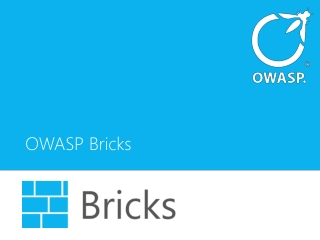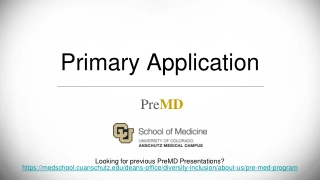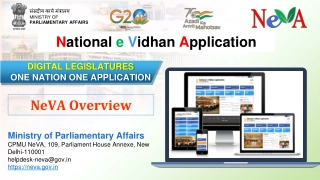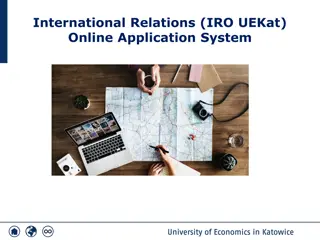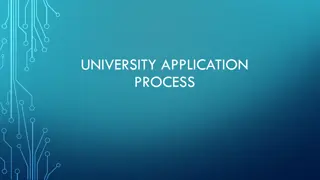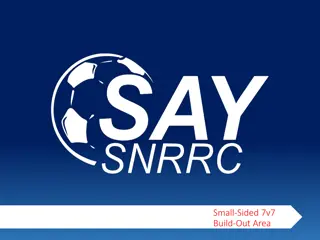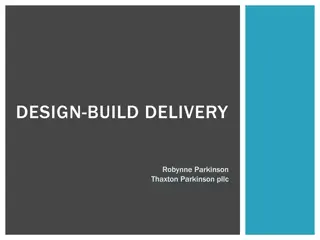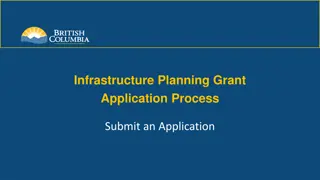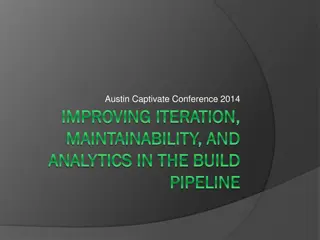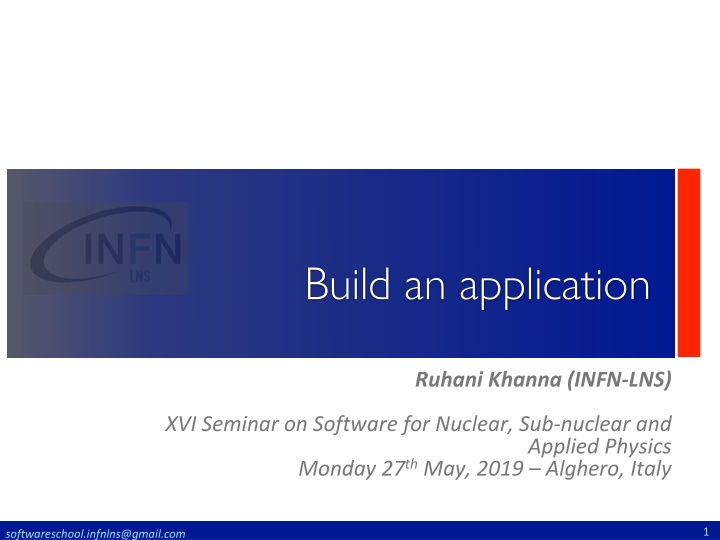
Building Nuclear and Applied Physics Software with CMake and Geant4
Learn how to build nuclear and sub-nuclear physics software applications using CMake and Geant4. Properly organize your code, create a CMakeLists.txt file, and compile your application with CMake. Understand the application source structure in Geant4 and utilize CMake for efficient building and configuration.
Download Presentation

Please find below an Image/Link to download the presentation.
The content on the website is provided AS IS for your information and personal use only. It may not be sold, licensed, or shared on other websites without obtaining consent from the author. If you encounter any issues during the download, it is possible that the publisher has removed the file from their server.
You are allowed to download the files provided on this website for personal or commercial use, subject to the condition that they are used lawfully. All files are the property of their respective owners.
The content on the website is provided AS IS for your information and personal use only. It may not be sold, licensed, or shared on other websites without obtaining consent from the author.
E N D
Presentation Transcript
Build an application Ruhani Khanna (INFN-LNS) XVI Seminar on Software for Nuclear, Sub-nuclear and Applied Physics Monday 27thMay, 2019 Alghero, Italy 1 softwareschool.infnlns@gmail.com
How to build an application 2 Properly organise your code into directories Prepare a CMakeLists.txt file Create a build directory and run Cmake Compile (using the make command) the application Run the application softwareschool.infnlns@gmail.com
Application source structure in Geant4 3 Official basic/B1 example: The text file CMakeLists.txt is the CMake script containing commands which describe how to build the exampleB1 application contains main() for the application Involves use of G4RunManager Header files Header -> declaration of methods -> any classes from which it inherits -> public or not Source Source -> code of each method Source files Macro file containing the commands softwareschool.infnlns@gmail.com
CMake 4 Cmake is a build configuration tool It takes configuration file (CMakeLists.txt) - It finds all the dependencies (in our case, GEANT4) - Creates Makefile to run the compilation itself - You have to write this CMakeLists.txt file softwareschool.infnlns@gmail.com
Cmakelist.txt File structure cmake_minimum_required(VERSION 2.6 FATAL_ERROR) project(B1) option(WITH_GEANT4_UIVIS "Build example with Geant4 UI and Vis drivers" ON) if(WITH_GEANT4_UIVIS) find_package(Geant4 REQUIRED ui_all vis_all) else() find_package(Geant4 REQUIRED) endif() Cmake minimum version and Project name Find and configure G4 include(${Geant4_USE_FILE}) include_directories(${PROJECT_SOURCE_DIR}/include) Configure the project to use G4 and B1 headers file(GLOB sources ${PROJECT_SOURCE_DIR}/src/*.cc) file(GLOB headers ${PROJECT_SOURCE_DIR}/include/*.hh) add_executable(exampleB1 exampleB1.cc ${sources} ${headers}) target_link_libraries(exampleB1 ${Geant4_LIBRARIES}) set(EXAMPLEB1_SCRIPTS exampleB1.in exampleB1.out init_vis.mac run1.mac run2.mac vis.mac ) List the sources Include -> configures header path and compiler flags and compiler definition needed for linking to Geant4 and loads a Cmake script supplied by Geant4 USE_FILE -> set to path to module when G4 is located by find package Copy any macro files to the Cmake -> Ensures use of a suitable version of cmake Project command -> sets name of project and enables and configures c and c++ compilers PROJECT -> (Cmake variable) points to directory of project in project command Define and link the executable Locates and configures Geant4 REQUIRED-> used so Cmake will fail with error if cannot find G4 Include directories -> adds B1 header directory to compilers header search path foreach(_script ${EXAMPLEB1_SCRIPTS}) configure_file( ${PROJECT_SOURCE_DIR}/${_script} ${PROJECT_BINARY_DIR}/${_script} COPYONLY ) build directory softwareschool.infnlns@gmail.com
Build directory and Cmake for our task application 6 1) If modifying the Geant4 examples, copy them to your $HOME first: cp -r /usr/local/geant4/geant4.10.03.p02/examples/basic/B1 ~ 2) Create a build directory*, where the compiled application will be put: mkdir -p ~/B1-build cd ~/B1-build B1 B1-build *Note: *Note: It is possible (though not recommended) to compile inside inside source directory. softwareschool.infnlns@gmail.com
Run CMake 7 Path to Geant4 In the build directory you just created, run CMake: cmake -DGeant4_DIR=/usr/local/geant4/geant4.10.03.p03-install/lib64/Geant4- 10.3.2/ ~/B1/ -- The C compiler identification is GNU 4.8.5 -- The CXX compiler identification is GNU 4.8.5 -- Check for working C compiler: /usr/bin/cc -- Check for working C compiler: /usr/bin/cc -- works -- Detecting C compiler ABI info -- Detecting C compiler ABI info - done -- Detecting C compile features -- Detecting C compile features - done -- Check for working CXX compiler: /usr/bin/c++ -- Check for working CXX compiler: /usr/bin/c++ -- works -- Detecting CXX compiler ABI info -- Detecting CXX compiler ABI info - done -- Detecting CXX compile features -- Detecting CXX compile features - done -- Configuring done -- Generating done -- Build files have been written to: /path/to/build/directory Path to source softwareschool.infnlns@gmail.com
Compilation 8 In the build directory, run make You have only a couple of files, it should be ready in a minute or two An executable with the name of your application is created (e.g. exampleB1) in build directory Macros and other auxiliary files are copied into build directory (and don t get a cup of coffee) make -j2 softwareschool.infnlns@gmail.com
Run the application - GUI 9 Just type the name of your application, including the ./ identifier of current directory (e.g. ./exampleB1) ./exampleB1 Available UI session types: [ Qt, GAG, tcsh, csh ] softwareschool.infnlns@gmail.com
Thank you softwareschool.infnlns@gmail.com
Tasks to do: Exercise 0.1: Find and understand the GEANT4 environment file Exercise 0.2: Check your Geant4 environment Exercise 0.3: compile and run the basic example B1 softwareschool.infnlns@gmail.com


